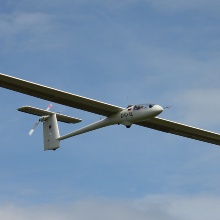The solar aircraft icaré glides smoothly and quietly over Mengen in the district of Sigmaringen. While it is in the air, scientists from the University of Stuttgart are gathering data on navigation and flight control. The work is carried out jointly by the Institute of Aircraft Design (IFB), the Institute of Flight Mechanics and Control (IFR) and the Institute of Navigation (INS).
Over three days of flying in August, the solar aircraft was in the air for up to two hours at a time and covered a distance of roughly 80 kilometers. As well as the solar cells and propellers on the wingtips, a GPS antenna behind the cockpit looks particularly striking. It measures the position of the aircraft to within an accuracy of one centimeter. This is much more precise than the GPS systems in your cell phone or your car, which are only accurate to within three to five meters. Thanks to the antenna it becomes possible to set reference trajectories (meaning flight paths) for all flights with centimeter precision.
Researchers use fiberoptic gyro systems known as IMUs as well as other devices to measure the altitude and position of the plane while in flight. These are installed inside the aircraft. “In layman’s terms, a gyro is like a three-dimensional spirit level which works in all directions”, explains Johannes Schneider, research assistant at the Institute of Aircraft Design. “The gyros measure whether the pilot is taxiing, tilting or yawing the aircraft and how intensely the plane is moving. By putting together all the measurements of the movements of the IMUs you can also calculate the aircraft’s position in the sky.”
Researchers are developing software for flying taxis
The biggest difference between the devices which the scientists are investigating is in how accurate they are. The researchers can use the measurements to compare various systems with one another and determine how well the individual devices work. They want to use the data to find algorithms that will compensate for the inaccuracy of a device – particularly with regard to the long and short-term stability of the IMUs. The scientists at the Institute of Navigation are developing a piece of software for this purpose.
The results should also serve to make autonomous flying safer and more reliable in future. There’s already a lot of talk about so-called Urban Air Mobility (UAM) using small flying taxis (Personal Air Vehicles)”, says Schneider. “Small aircraft for two to four passengers are being developed which are also intended to fly autonomously in future. This is why it is essential for the aircraft to know exactly where it is at all times.
Additional tests on icaré with wingtip propellers
Prof. Andreas Strohmayer from the IFB and Prof. Walter Fichter from the IFR as well as their teams have also continued the test flights with wingtip propellers to manage the yaw. These were jointly developed by the institutes and tested for the first time in 2019. While carrying out the tests the pilots reviewed the new IFR control algorithms, which make flying coordinated turns easier and automatically reduce the angle of yaw.
The icaré project
The solar aircraft icaré has been operating as a test plane belonging to the Faculty of Aerospace Engineering at the University of Stuttgart for almost 25 years. The icareans, as those working on the icaré project call themselves, carried out the three days of test flights at the newly-created eFliegenBW testing ground at the airfield in Mengen. The wingtip propulsion project is supported by the technical support team from SFL GmbH, which is a spin-off of the University of Stuttgart. The test flights were piloted by Werner “micro” Scholz, a former employee at the Institute of Aircraft Design, who was previously involved in building the icaré.




